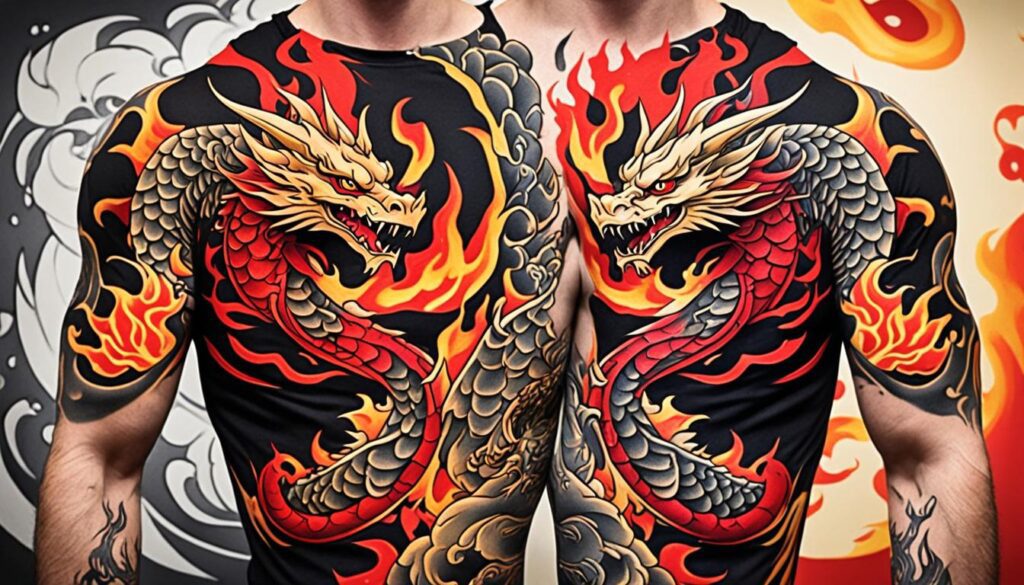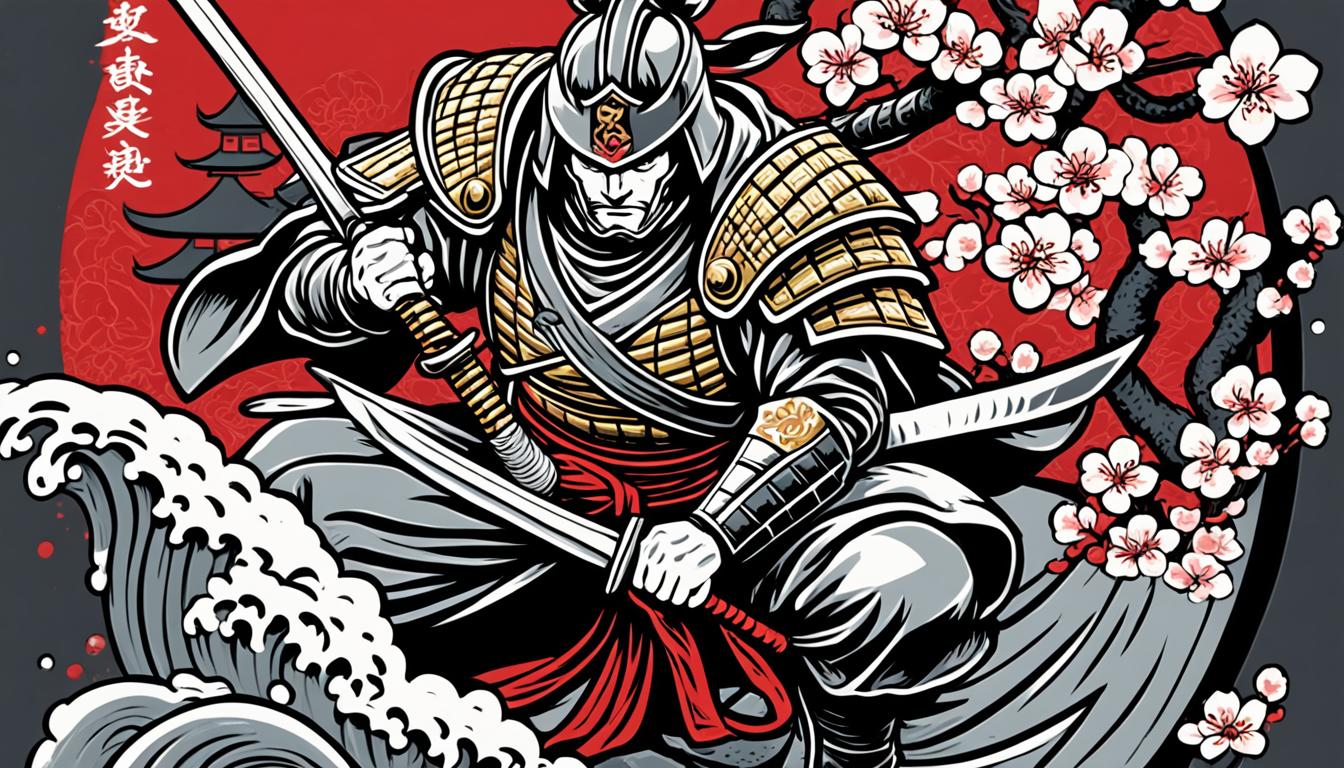Are you fascinated by the art of tattoos and interested in Japanese tattoo designs? Understanding the Japanese term for “tattoo” can enhance your appreciation for this ancient art form. In this guide, we will explore the meaning, grammar, pronunciation, and cultural context of the word “tattoo” in Japanese.
Traditional Japanese Tattoo Meanings and Designs
Traditional Japanese tattoos have a deep-rooted symbolism and are inspired by myths, legends, and traditional stories. These tattoos convey profound meanings and are revered for their artistic representation. Let’s explore some popular traditional Japanese tattoo designs and their significance:
Japanese Dragon Tattoo
The Japanese dragon tattoo is an iconic design that symbolizes strength, wisdom, and divine blessings. It can take various forms, incorporating elements of different animals or mythical creatures, such as serpents or tigers. This majestic creature represents power and protection, making it a popular choice among tattoo enthusiasts.
Japanese Turtle Tattoo
The Japanese turtle tattoo often portrays troublemakers and law-breakers. It draws inspiration from the mythological creature known as Kappa, a mischievous and cunning turtle-like being. Getting a turtle tattoo signifies a rebellious nature or defiance against societal norms.
Tengu Tattoo
Tengu tattoos depict supernatural creatures with demonic features. These mythical beings are typically portrayed with a red face and a long nose. Tengu tattoos symbolize strength, courage, and spiritual enlightenment. The vibrant red and black colors used in these tattoos create a bold and striking appearance.
Japanese Koi Fish Tattoo
Koi fish tattoos are renowned for their vibrant colors and intricate details. These designs represent wealth, success, and the ability to overcome obstacles. The koi fish’s journey against the current symbolizes resilience and determination. Whether swimming upstream or transforming into a dragon, the koi fish tattoo holds significant meaning and is sought after by tattoo enthusiasts.
Japanese Lion Tattoo
Karajishi, a mythical creature combining the characteristics of a lion and a dog, is the inspiration behind Japanese lion tattoos. These tattoos symbolize courage, bravery, and strength. Karajishi tattoos are often depicted with a fearsome expression, showcasing the lion’s protective nature. They make a powerful statement and carry a rich history within Japanese tattoo culture.
Japanese Snake Tattoo
Snake tattoos in Japanese culture represent rebirth and transformation. The snake shedding its skin is a symbol of renewal and personal growth. These tattoos often emphasize the snake’s sleek and sinuous form, capturing the mystic allure of this ancient creature.
Japanese Phoenix Tattoo
The phoenix holds immense significance within Japanese tattoo art. It symbolizes the imperial household and represents the cycle of life, death, and rebirth. A phoenix tattoo can embody both harmony and disharmony, signifying the delicate balance of existence and the ever-changing nature of life.
These are just a few examples of the diverse meanings and designs found in traditional Japanese tattoos. Each tattoo represents a unique story and carries a way of life deeply ingrained in Japanese culture. By choosing a traditional Japanese tattoo, you embrace the rich history and symbolism associated with this ancient art form.
The Symbolism of Japanese Tattoo Colors

Colors play an important role in traditional Japanese tattoos. Each color carries its own significance and adds depth to the overall design. Let’s explore the meaning of Japanese tattoo colors and their symbolism.
White, often used as a background color, represents innocence and purity. It symbolizes a fresh start and a blank canvas for new beginnings. White also highlights the other colors in the tattoo and enhances their impact.
Black is a classic color in traditional Japanese tattoos. It represents masculinity and strength. Black tattoos are also associated with the underground tattoo culture and have a rebellious and edgy connotation.
Red is a powerful color that symbolizes love, bravery, and power. It represents intense emotions and can depict both beauty and destruction. Red is often used in Japanese tattoo designs to convey passion and energy. It is commonly seen in tattoos of mythical creatures like dragons.
Blue is associated with masculinity, fertility, and protection. It represents calmness and tranquility. In Japanese tattoos, blue is often used to depict water, waves, and the sea. It adds a sense of movement and flow to the design.
Gold or yellow is a color that represents strength, prosperity, and good luck. It symbolizes wealth and abundance. Gold is often used to accentuate certain elements in a tattoo and add a touch of luxury.
Traditional Japanese tattoos often incorporate multiple colors to convey different meanings and create a visually stunning design. For example, koi fish tattoos are known for their vibrant colors, and each color variation has its own significance. A red koi represents love and passion, while a black koi symbolizes overcoming obstacles. A blue koi represents masculinity and fertility, while a gold or yellow koi represents wealth and success.
Understanding the meaning of Japanese tattoo colors is essential to fully appreciate the rich symbolism behind traditional Japanese tattoos. It allows individuals to choose colors that resonate with their personal values and reflect their desired message in their tattoo design.
Japanese Traditional Tattoo Symbols
Japanese traditional tattoos are renowned for their intricate designs and rich symbolism. These tattoos incorporate a diverse range of symbols that hold deep cultural significance. Each symbol represents a unique concept and adds layers of meaning to the overall tattoo design.
The dragon is a popular symbol in Japanese traditional tattoos, representing strength, wisdom, and good fortune. Often depicted with vibrant colors and intricate details, the dragon is a dynamic and powerful image.
Another significant symbol is the tiger, which symbolizes courage and protection. Tigers are believed to bring good luck and ward off evil spirits.
The koi fish is another prominent symbol in Japanese traditional tattoos, representing bravery, determination, and success. The koi fish is often depicted swimming upstream, symbolizing perseverance and the ability to overcome obstacles.
Cherry blossoms, known as sakura, are delicate flowers that symbolize the transience of life, reminding us to cherish each moment. These beautiful flowers are often incorporated into Japanese tattoo designs to depict beauty, fragility, and the impermanence of existence.
Skulls are used to pay respects to the deceased and represent the impermanence of life. They serve as a reminder of the cycle of life and death, a symbol of mortality.
The Hannya mask, a traditional Japanese theater mask representing a jealous woman transformed into a demon, is a powerful symbol of transformation and inner conflict.
Another significant symbol in Japanese traditional tattoos is the phoenix. The phoenix symbolizes rebirth, immortality, and resilience. It represents the ability to rise from the ashes and overcome adversity.
The snake is yet another symbol often seen in Japanese traditional tattoos. It represents protection, transformation, and healing. The snake sheds its skin, symbolizing the ability to let go of the past and embrace change.
These symbols are intricately woven into the designs of traditional Japanese tattoos, creating visually stunning and deeply meaningful works of art. Each symbol has its own story, rooted in Japanese culture and mythology.
The Importance of Size and Detail in Traditional Japanese Tattoos
Traditional Japanese tattoos are renowned for their impressive size and meticulous detail. These tattoos span extensive areas of the body, such as the sleeve, shoulder, and back. The generous size of these tattoos allows skilled artists to incorporate various elements, resulting in a harmonious and cohesive design.
The intricate line work and shading in traditional Japanese tattoos bring them to life, adding depth and dimension. Each meticulously crafted detail contributes to the overall visual impact, resulting in a stunning piece of body art that captures the essence of the design. The level of detail in these tattoos requires the expertise of specialized artists who possess a deep understanding of the style.
Size and detail play a crucial role in the artistry and craftsmanship of traditional Japanese tattoos. The large scale of these tattoos creates a canvas that can accommodate the intricate designs, enabling artists to breathe life into the stories, mythical creatures, and symbols they represent. With painstaking precision, the artists skillfully execute every line, creating a mesmerizing visual narrative.
When it comes to traditional Japanese tattoos, size matters. Whether it’s a bold and vibrant dragon winding its way across the body or a delicately shaded cherry blossom, the size and detail contribute to the overall impact and aesthetic beauty of the tattoo. These artistic masterpieces celebrate Japanese culture, mythology, and symbolism, capturing the imagination of both wearers and admirers.

